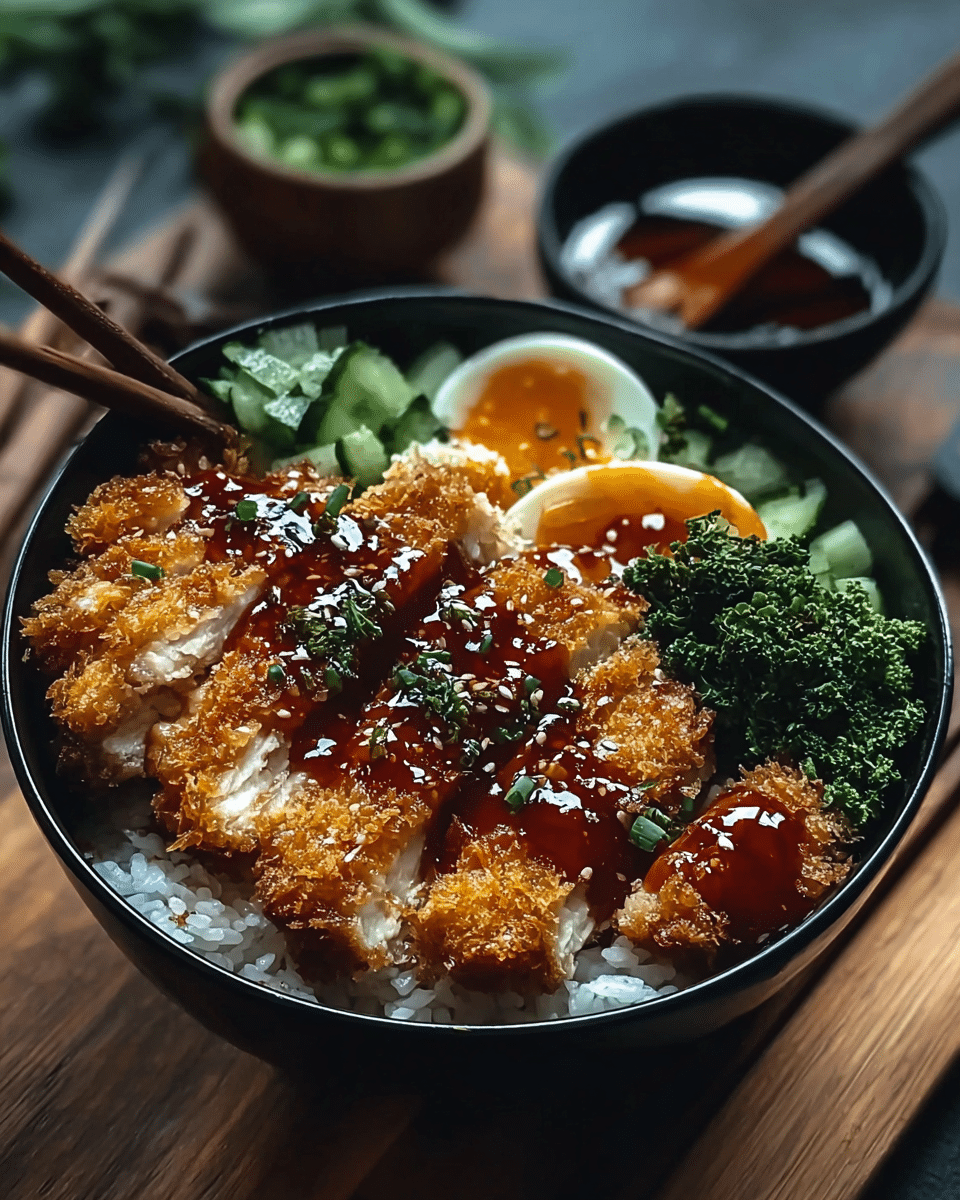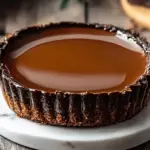The Japanese Chicken Katsu Bowl is a beautiful marriage of textures and flavors the crunch of golden panko-coated chicken, the fluffiness of perfectly seasoned rice, and the bold, tangy sweet punch of tonkatsu sauce. Topped with crisp cabbage and a sprinkle of sesame seeds, it’s a dish that’s as pleasing to the eyes as it is to the taste buds.
Originally inspired by Western-style breaded cutlets, katsu has evolved into a beloved Japanese comfort food. This bowl format makes it easy to enjoy all the traditional flavors in one complete meal. Whether you’re making it for a cozy family dinner or a weekend indulgence, this recipe will bring a little taste of Japan right to your home kitchen.
Full Recipe:
Ingredients:
For the Katsu:
-
2 boneless chicken breasts (or pork loin, if preferred)
-
Salt and pepper, to taste
-
1 cup all-purpose flour
-
2 large eggs
-
1 cup panko breadcrumbs
-
Vegetable oil, for frying
For the Rice:
-
2 cups Japanese short-grain rice
-
2 ½ cups water
-
1 tablespoon rice vinegar
-
1 tablespoon sugar
-
½ teaspoon salt
For the Sauce:
-
¼ cup tonkatsu sauce (store-bought or homemade)
-
1 tablespoon soy sauce
-
1 teaspoon Worcestershire sauce
-
1 teaspoon ketchup
Toppings:
-
1 cup shredded cabbage
-
2 green onions, sliced
-
Sesame seeds, for garnish
-
Pickled ginger (optional)
Directions:
-
Prepare the Rice: Rinse rice under cold water until water runs clear. Transfer to saucepan, add water, and soak for 30 minutes. Cover and bring to a boil, reduce heat, and simmer for 15 minutes without lifting the lid. Remove from heat and let sit covered for 10 minutes. Mix vinegar, sugar, and salt until dissolved, then fold into rice gently.
-
Prepare the Katsu: Pound chicken to ½-inch thickness and season with salt and pepper. Set up breading station with flour, beaten eggs, and panko. Dredge chicken in flour, dip in eggs, and coat with panko, pressing crumbs to adhere.
-
Fry the Katsu: Heat oil in skillet over medium heat. Fry chicken for 4–5 minutes per side until golden brown and cooked through (internal temp 165°F/75°C). Drain on paper towels and rest before slicing.
-
Make the Sauce: In a bowl, mix tonkatsu sauce, soy sauce, Worcestershire sauce, and ketchup until well combined.
-
Assemble the Bowl: Place rice in serving bowls, top with sliced katsu, shredded cabbage, green onions, and sesame seeds. Drizzle with sauce and garnish with pickled ginger if desired.
Prep Time: 30 minutes | Cooking Time: 30 minutes | Total Time: 1 hour
Kcal: 520 kcal | Servings: 4 servings
Japanese Chicken Katsu Bowls A Deep Dive into Japan’s Crispy Comfort Food
Japanese Chicken Katsu Bowls are more than just a meal they’re an experience in balance, texture, and tradition. This beloved dish combines the satisfying crunch of panko-breaded chicken with the soft fluffiness of perfectly seasoned rice, all tied together by the tangy-sweet embrace of tonkatsu sauce. It’s a staple in Japanese home kitchens, restaurants, and bento boxes, adored for its straightforward preparation and universally appealing flavor.
What makes this dish so irresistible is its harmony. In Japanese cooking, balance is everything not only in taste but also in presentation and texture. The crispiness of the chicken plays against the tenderness of the rice, while the sauce adds a savory-sweet complexity that elevates every bite. The addition of fresh toppings like shredded cabbage, green onions, and sesame seeds brings freshness, crunch, and visual appeal.
A Short History of Katsu in Japan
The origins of katsu (short for “katsuretsu,” meaning cutlet) date back to the late 19th century, during the Meiji era, when Japan began adopting Western culinary techniques. Influenced by European breaded meat dishes such as the French côtelette or Austrian schnitzel, Japanese chefs adapted the concept to local tastes, replacing heavy batters with airy, crispy panko breadcrumbs and serving the cutlets alongside rice instead of potatoes or bread.
Originally made with pork (tonkatsu), the chicken variation gained popularity in the mid-20th century. Chicken Katsu is now a common alternative in homes and restaurants, especially for those seeking a lighter flavor or avoiding pork. The donburi-style presentation serving the katsu over rice in a bowl developed later, allowing the dish to be enjoyed as a one-bowl meal, ideal for busy lifestyles.
The Signature Elements of a Japanese Chicken Katsu Bowl
A proper Chicken Katsu Bowl is a study in simplicity done right. While the main star is the crispy chicken cutlet, each element plays a crucial role:
-
Crisp Coating: The panko breadcrumbs create a texture that’s lighter and crunchier than traditional Western breadcrumbs, ensuring every bite has a delicate crispness without feeling greasy.
-
Seasoned Rice: The rice is more than just a side; it’s seasoned with a gentle blend of rice vinegar, sugar, and salt, giving it a subtle tang that balances the richness of the fried chicken.
-
Bold Sauce: Tonkatsu sauce a Japanese condiment with similarities to Worcestershire sauce provides sweet, tangy, and umami flavors. The combination of fruits, vegetables, soy sauce, and spices makes it both refreshing and savory.
-
Fresh Toppings: Raw shredded cabbage is a classic pairing, as its crisp freshness contrasts beautifully with the fried chicken. Sesame seeds, green onions, and pickled ginger add further texture, color, and flavor depth.
Why Japanese Katsu Bowls Are Loved Worldwide
Several reasons explain why katsu bowls have gone beyond Japan’s borders to win global hearts:
-
Familiar Yet Unique: Breaded fried chicken is familiar worldwide, but pairing it with seasoned Japanese rice and tonkatsu sauce creates a distinctive twist.
-
Customizable: You can swap chicken for pork, fish, shrimp, or even plant-based alternatives like tofu or eggplant.
-
Comfort Food Vibes: Warm, crispy, and hearty the very definition of comfort food, yet light enough for regular enjoyment.
-
Bento-Friendly: Leftovers pack perfectly into lunch boxes, staying tasty even at room temperature.
Tips for the Perfect Chicken Katsu Bowl
If you’re making this at home and want restaurant-quality results, here are a few expert tips:
-
Use Panko, Not Regular Breadcrumbs: Panko’s light, airy texture creates a superior crisp.
-
Control the Oil Temperature: Frying at 340–350°F (170–175°C) ensures a golden crust without burning or becoming greasy.
-
Don’t Overcrowd the Pan: Fry in batches so each cutlet cooks evenly and stays crisp.
-
Let the Chicken Rest Before Slicing: This prevents juices from escaping and keeps the meat tender.
-
Season the Rice While Warm: This allows the seasoning to absorb fully and evenly.
Creative Variations
While the classic chicken version is timeless, experimenting with flavors can make katsu bowls even more exciting:
-
Spicy Katsu Bowl: Add chili oil or sriracha to the tonkatsu sauce for a fiery kick.
-
Cheese Katsu Bowl: Place a slice of cheese between two thin chicken fillets before breading for a molten cheese center.
-
Teriyaki Katsu Bowl: Swap the tonkatsu sauce for a thick teriyaki glaze.
-
Vegetarian Katsu Bowl: Use thick slices of eggplant or firm tofu as the cutlet base.
-
Katsu Curry Bowl: Replace the tonkatsu sauce with Japanese curry for a rich and aromatic alternative.
Serving Suggestions and Pairings
A Chicken Katsu Bowl is often served with complementary sides that enhance its flavors:
-
Miso Soup: A light, savory soup that balances the richness of the fried chicken.
-
Pickles (Tsukemono): Adds acidity and crunch, cutting through the heaviness of the katsu.
-
Japanese Potato Salad: Creamy and mild, pairing beautifully with the tangy sauce.
-
Green Tea: A traditional beverage that refreshes the palate.
For presentation, a well-arranged katsu bowl should showcase neat slices of golden chicken on one side of the bowl, with the rice base peeking through and the vibrant toppings providing contrast.
Cultural Significance and Popularity
In Japan, katsu dishes are sometimes eaten as a symbol of good luck, especially before important exams or competitions. This tradition stems from the word “katsu,” which also means “to win” or “to be victorious” in Japanese. Students and athletes often eat katsu meals before big events as a tasty good-luck charm.
In restaurants, katsu bowls range from casual eateries to high-end establishments. In homes, they are valued for their versatility equally suitable for a family dinner or a solo meal. Japanese Chicken Katsu Bowls are also a popular choice for people exploring Japanese cooking for the first time, as the ingredients are widely available and the technique is approachable.
Why This Dish Deserves a Spot on Your Menu
If you run a food blog or restaurant, Chicken Katsu Bowls are an excellent addition to your menu lineup for several reasons:
-
Wide Appeal: The combination of fried chicken and rice is hard to resist for most palates.
-
Photogenic: The contrasting colors and textures make it visually stunning for food photography.
-
Customizable for Diets: Can be adapted to gluten-free, vegetarian, or lighter versions with ease.
-
Meal Prep Friendly: Portions can be prepared ahead and assembled quickly before serving.
Conclusion:
The Japanese Chicken Katsu Bowl is a perfect example of culinary harmony a dish where every element plays an essential role, from the crisp golden coating of the chicken to the seasoned rice and the tangy-sweet sauce. Rooted in Japan’s cultural blending of East and West, it has evolved into a comfort food that’s enjoyed both domestically and internationally.
Whether served in a traditional Japanese diner, plated elegantly in a fine restaurant, or enjoyed from a home kitchen, its universal appeal lies in its balance of flavors, textures, and presentation. With endless possibilities for customization, it invites creativity while staying true to its comforting roots.
Adding a Chicken Katsu Bowl to your culinary repertoire is not just about making a meal it’s about sharing a piece of Japan’s food culture, delivering warmth, satisfaction, and a crispy bite of victory in every mouthful.






